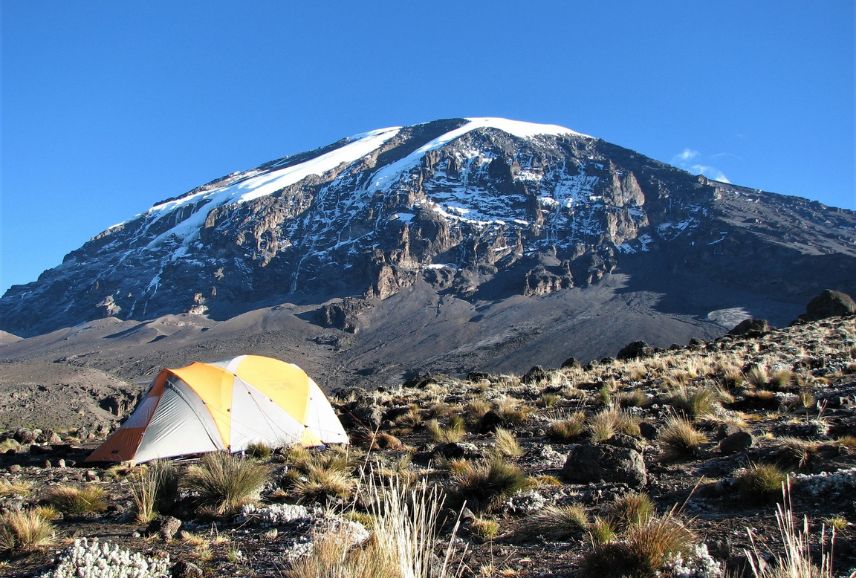
As you hike up the mountain you will notice how drastically and frequently the landscape changes. The air will become thinner, the vegetation will change and so will the wildlife that inhabits the area. You will want to bring items of clothing that are breathable and that can be layered. The sun is extremely intense here and everyone should bring the maximum number SPF sunscreen possible. Even people who normally don’t burn will be surprised at how strong the sun’s rays are up here. Here, we walk you through the climatic changes of the hike, from just stepping out of the vehicle to what you’ll see and experience at the summit.
Don’t forget to stretch first!

The base elevation is approximately 2000 m (6562 ft). Despite the relatively high altitude it is hot like in the plains but there is abundant water flowing from further up the mountain. Starting off the hike you may feel very hot and sticky, particularly during the summer months (Dec – March).
The first part of your journey will take you through mountain forest. This is the wettest area of Kilimanjaro, with over 90% of water on Kilimanjaro falling as rain in this zone.
Common trees in the forest are Podocarpus milanjianus – a soft wood related to the pines. Its green berries have a red edible fleshy part much favored by monkeys, turacos and hornbills.
Other trees include:
Junipers rocera - the twisted juniper reaches 30 m (295 ft) in height.
Ilex mitisa – an elegant tree that grows mainly in the upper reaches of the forest.
Otea usambarinsis – a massive tree often 40 m (131 ft) tall which has dark red fluted bark.
Olea kilimandscharica – this olive tree grows in the drier section of the forest (western and northern slopes). It is an important timber and grows up to 30 m (295 ft) tall.
Hagenia abyssinica – this rosewood tree is huge and has dark red-brown hanging clusters of flowers.
Agauria salicfolia – a gnarled tree with rough reddish bark.
Nuxia congesta – a squat tree with a vast fluted trunk. This tree produces clusters of small white flowers.
The animals that live in this forest include black and white colobus monkeys, blue monkeys and olive baboons. Buffalo, elephants and elands also live here but they are seldom seen. The elusive leopard also lives throughout the forest but most times the presence of fur-filled droppings is the only indication of them. Many bird calls can be heard in the forest. These birds include: common bulbul, Hautlaub’s turacos, silvery-cheeked hornbill and the tropical boubou.

Higher up Kilimanjaro becomes too cold and dry for trees to grow and the forest zones ends. It is here where the heather zone begins. It takes its name from the giant Heather trees, Erica orborea,which dominates large areas.
The Heather zone is also dominated by shrubs like:
Hyericum revolutum –This plant can grow up to 5 m (16 ft) tall and has large yellow, open cup-shaped flowers. This plant is related to St John’s Wort, a well known English garden plant.
Adenocarpus manni – a member of the pea family that thrives in high altitudes.
Protea kilimanscharica – a very distinctive plant with a large ball-shaped cream or yellow flowers and stiff leather evergreen leaves. Many types of proteas grow in South Africa where it is their National emblem.
Leonotis mollissima – aka the lion’s paw, is a tall shrub with flowery spikes.
There are sunbirds in this zone and species seen include Eastern Double-Collared Sunbirds and Malachite Sunbirds.

The alpine zone experiences dramatic variations in temperature between day and night. Night often get below freezing and days can see ground temperatures reach over 40 C (104 F). Water is very limited with annual precipitation around 125 mm (4.92 inches) per year. No large animals live here but buffalos, lions, leopards and eland occasionally visit the zone. Larger birds regularly visit the moorland and alpine zones to find food. These birds include: augur buzzards, crowned eagle, mountain buzzards and white necked raven.
| Destination | Mt Kilimanjaro |
|---|---|
| Location | Mt Kilimanjaro, Tanzania |
| Attraction | A must see for all mountain lovers. |